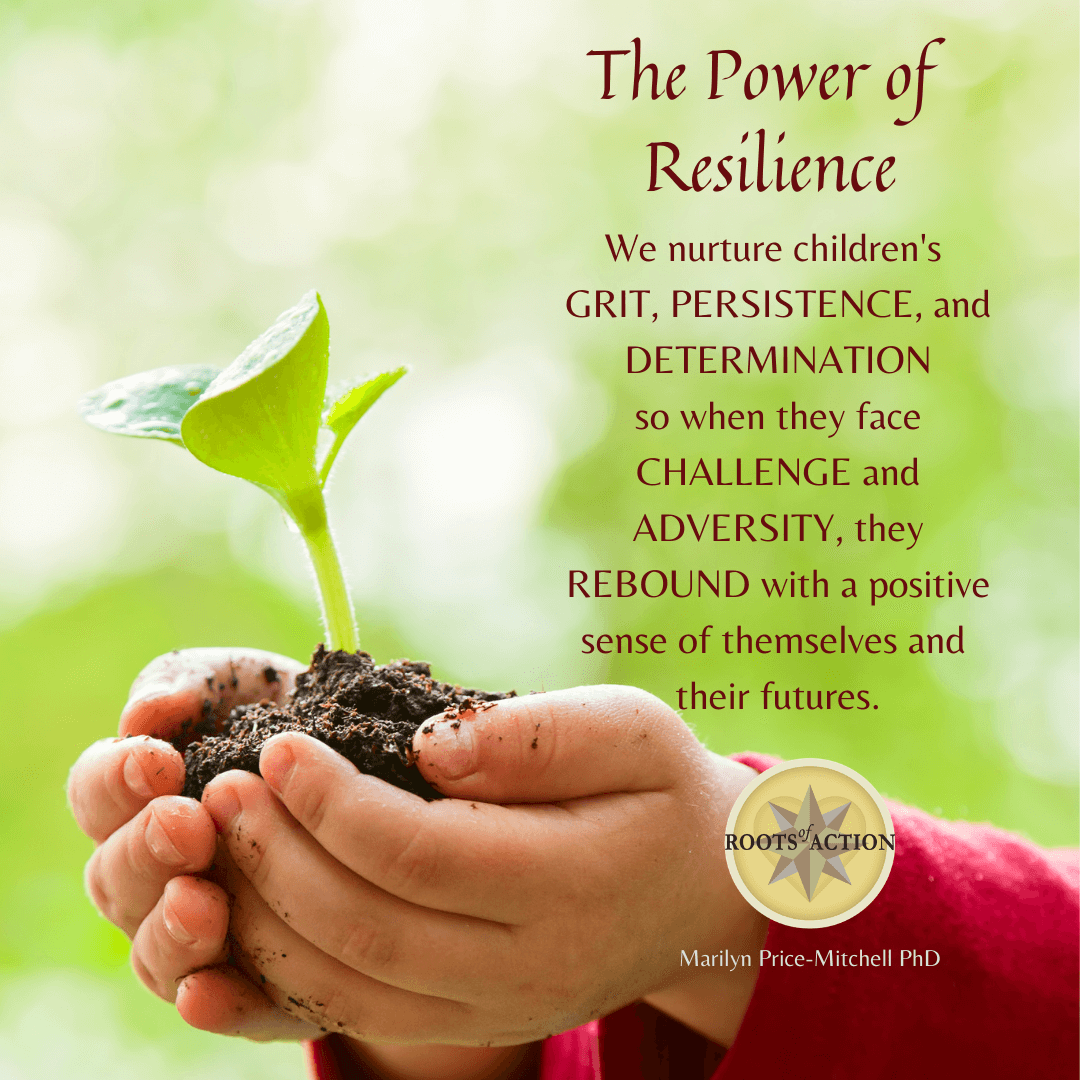
Over 100 years ago, the great African American educator Booker T. Washington spoke about building resilience: “I have learned that success is to be measured not so much by the position that one has reached in life as by the obstacles overcome while trying to succeed.”
Research has since established resilience as essential for human thriving, and an ability necessary for the development of healthy, adaptable young people.
What is Resilience?
Resilience is an individual’s psychological capacity for positive adaptation despite adversity. Researchers have mostly studied the protective factors that counterbalance adversity in children, but resilience can be strengthened at any age.
Building resilience is important for individuals and social systems, including schools, families, and organizations. Research shows that a child’s resilience is improved when they are members of classrooms and other groups that promote adaptability.
Resilience is derived from the ways children learn to think and act when faced with obstacles large and small. The road to resilience comes first and foremost from children’s supportive relationships with parents, teachers, and other caring adults. These relationships become sources of strength when children work through stressful situations and painful emotions. When teachers help young people cultivate an approach to life that views obstacles as a critical part of success, they are building resilience.
How to Recognize Resilience in Children?
A key to building resilience in the K-12 classroom is being able to recognize behaviors that are indicators of resilience. Research shows that resilient children express feelings of hope, optimism, and faith about their futures; convey positive emotions; and value social connections.
Resilience is part of The Compass Advantage (a framework for engaging families, schools, and communities in the principles of positive youth development) because the capacity to rebuild and grow from adversity is a key factor in achieving optimal cognitive, social, emotional, and physical health. Linked by research to happiness and the other attributes on the compass, resilience is one of the eight abilities kids need to succeed.
The ability to meet and overcome challenges in ways that maintain or promote well-being plays an essential role in how students learn to achieve academic and personal goals. Resilient young people feel a sense of control over their own destinies. They know that they can reach out to others for support when needed, and they readily take initiative to solve problems. Teachers who focus on building resilience in students by helping them think about various paths through adversity and teaching habits of mind that foster adaptability contribute to a child’s well-being for a lifetime.
Five Ways of Building Resilience in Your Classroom
1. Promote self-reflection through literary essays or small-group discussions.
Short written essays or small-group discussion exercises that focus on heroic literary characters are an excellent way, particularly for younger students, to reflect on resilience and the role it plays in life success. After children have read a book or heard a story that features a heroic character, encourage them to reflect by answering the following questions. (See the Heroic Imagination Project for additional resources and videos.)
- Who was the hero in this story? Why?
- What challenge or dilemma did the hero overcome?
- What personal strengths did the hero possess? What choices did he or she have to make?
- How did other people support the hero in building resilience?
- What did the hero learn?
- How do we use the same personal strengths when we overcome obstacles in our own lives? Can you share some examples?
2 Encourage reflection through personal essays.
Written exercises that focus on sources of personal strength can help middle and high school students learn strategies for building resilience. For example, by exploring answers to the following questions, students can become more aware of their strengths and what they look for in supportive relationships with others.
- Write about a person who supported you during a particularly stressful or traumatic time. How did they help you overcome this challenge? What did you learn about yourself?
- Write about a friend that you supported as he or she went through a stressful event. What did you do that most helped your friend? What did you learn about yourself?
- Write about a time in your life when you had to cope with a difficult situation. What helped and hindered you as you overcame this challenge? What learning did you take away that will help you in the future?
3. Help children (and their parents) learn from student failures.
In her insightful article Why Parents Need to Let Their Children Fail, published in The Atlantic, middle school teacher Jessica Lahey touched on a topic near and dear to every teacher’s heart: How do I teach students to learn and grow through failure and setbacks when their parents are so intent on making them a shining star? The truth is that learning from failure is paramount to building resilience in young people. Teachers help when they:
- Create a classroom culture where failure, setbacks, and disappointment are an expected and honored part of learning.
- Establish and reinforce an atmosphere where students are praised for their hard work, perseverance, and grit, not just for grades and easy successes.
- Hold students accountable for producing their own work, efforts from which they feel ownership and internal reward.
- Educate and assure parents that supporting kids through failure is an important way of building resilience– one of the best developmental outcomes that they can give their children.
4. Bring discussions about building resilience into the classroom.
Opportunities abound to connect resilience with personal success, achievement, and positive social change. Expand discussions about political leaders, scientists, literary figures, innovators, and inventors beyond what they accomplished to the personal strengths they possessed and the hardships they endured and overcame to reach their goals. Help students learn to see themselves and their own strengths through these success stories.
5. Build supportive relationships with students.
Good student-teacher relationships are those where students feel seen, felt, and understood by teachers. This happens when teachers are attuned to students, when they notice children’s needs for academic and emotional support. These kinds of relationships are key to building resilience. When adults reflect back on teachers who changed their lives, they remember and cherish the teachers who encouraged and supported them through difficult times.
References
Cohn, M. A., Fredrickson, B. L., Brown, S. L., Mikels, J. A., & Conway, A. M. (2009). Happiness unpacked: Positive emotions increase life satisfaction by building resilience. Emotion, 9(3), 361-368. https://doi.org/10.1037/a0015952
Luthar, S. S. (2015). Resilience in development: A synthesis of research across five decades. In D. Cicchetti & D. J. Cohen (Eds.), Developmental Psychopathology (pp. 739-795). https://doi.org/10.1002/9780470939406.ch20
Masten, A. S., & Obradovic, J. (2006). Competence and resilience in development. Ann N Y Acad Sci, 1094, 13-27. https://doi.org/10.1196/annals.1376.003
Noble, T., & McGrath, H. (2012). Wellbeing and Resilience in Young People and the Role of Positive Relationships. In S. Roffey (Ed.), Positive Relationships: Evidence Based Practice across the World (pp. 17-33). Springer Netherlands. https://doi.org/10.1007/978-94-007-2147-0_2
Student Success Series for Educators
Read the nine articles in the Student Success Series:
Student Success Develops from Inside Out – (Series Introduction)
Curiosity is a Core Predictor of Academic Performance
Social Emotional Development in the Classroom
Building Resilience in Your K-12 Classroom
Metacognitive Strategies for Student Success
Academic Integrity is Essential to Learning
Teach Students to Achieve Goals
Creative Thinking Sparks Student Engagement & Discovery
What Is Empathy? How To Cultivate It In the Classroom
Free Resources for Teachers
The Compass Youth Survey for Students ages 10-17: An online survey that can help students identify, understand, and strengthen their core abilities and impact their success as a student.
Our Community Promise: a frame-ready document that many teachers have hung in their classrooms to remind them and their students of the kind of values and habits of thinking that nurture student success.
I Have a Dream: a frame-ready document created by teens that define genuine success—to engage your students.
Reframing Success: Helping Children & Teens Grow from the Inside Out: an eBook that introduces The Compass Advantage. This eBook has been widely used by schools as a “Book Club” reading to engage parents about raising healthy children and teens.
Related Articles About Building Resilience
Quotes About Resilience That Foster Children’s Determination and Self-Confidence
Learning from Mistakes: Helping Kids See the Good Side of Getting Things Wrong
Published: January 11, 2022





